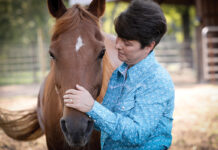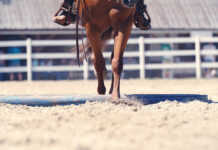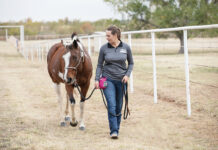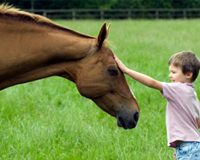There was a good reason old Aunt Edna didn’t fancy having young children come visit. Filled with enticing nooks and crannies, trinkets and breakable objects of all kinds, her home was hardly “child proof.”
Whether you are expecting a foal soon or already have one on the ground, foal-proofing the premises is a priority in order to keep the youngster safe.

In the Barn
If your broodmare will be delivering in a foaling stall, get a “foal’s eye view” of the maternity ward by actually getting down on your hands and knees and looking around the stall. This unique vantage point can reveal potential dangers (loose boards, splinters, gaps between boards or doors, protruding nails, et cetera) that you might not notice from your usual standing position. Remove or repair anything a foal might injure himself on.
Make sure stall walls are smooth and the foal cannot get a hoof or leg caught under the bottom of a door or wall. Don’t leave halters on the mare or foal when they are loose in the stall. A foal can get his legs caught in mom’s halter or his own halter. It only takes a minute to put the halter on and take it off. These lessons in handling are part of his early education.
All feeders and waterers–both in the stall and outside–should have smooth edges to protect the foal and any other horses on the grounds. Put waterers at approximately waist level. Feeders should not be higher than this; all horses are designed to eat at ground level.
“Make sure there are no sharp points anywhere,” says Wade Bullock, DVM, who has worked with breeding stock, show horses and pleasure horses at his Levy Animal Clinic located in Williston, Fla., for more than 20 years. “If the horse raises his head suddenly, he can tear an eyelid.” Or worse.
Avoid using feeders or waterers that a foal can get trapped in. (Author’s note: I know of at least one foal that died after climbing into an old tractor tire that was used as a hay feeder. He laid down, but got his head and neck stuck inside the tire rim. When he tried to get up, he panicked. The result was disastrous.) Even though foal safety and horse safety are basically interchangeable, foals can get into places a grown horse cannot. You must always look at any horse facility and ask yourself, “How can a horse possibly get hurt here and what can I do to prevent that?”
Shavings are popular for bedding, but avoid using them for foaling as they will stick to the wet foal. Straw is recommended for foaling. If you like shavings, switch back to them after the foal is a few days old, but keep an eye on the youngster as some foals tend to eat shavings.
Keep aisleways free of potentially dangerous objects such as wheelbarrows, rakes, forks, tractors, et cetera. Don’t let the foal run loose in hopes that he follows you and the mare. If the foal wanders off to explore something—an empty feed bucket, a muck tub, a boarder’s horse reaching his head over the stall door—you have no way of controlling him.
Turnout Practices
Ideally, mare and baby should have their own accommodations until the foal is about two weeks old. If there are other mares and foals turned out together, gradually introduce your mare and foal to the group by putting them out with only one other mare and foal at first. Don’t turn them out with geldings, or mares without foals, as they may act dangerously aggressive toward the foal. “People need to realize that horses create pecking orders; if we try to break this, it creates conflict,” Bullock notes. “Once they have an established pecking order, we need to honor that as long as they’re not hurting each other.”
For example, lead the dominant mare and her foal out of the pasture first rather than making her wait, as she’s likely to act aggressively to other horses if you change the routine.
“Never turn horses out into new surroundings at night,” Bullock cautions. “I’ve seen disasters from horses running through fences because of this.”
When feeding foals and broodmares in pasture, place several feed tubs spaced far apart—more than there are horses may be preferable. This minimizes the risk of injury to a foal from dominant mares that become aggressive at feed time.
Fencing for Foals
There is no such thing as 100 percent safe fencing, but certain fencing is much safer for foals than others. Optimal fencing prevents foals from getting trapped, won’t break upon impact, is highly visible and keeps predators out. Many types of fencing, including typical post-and-rail fencing, can be a hazard if a foal lies down close to the fence and gets trapped underneath when trying to stand. Also, if post-and-rail fencing is made of wood, a foal can become injured if he crashes into a board that splinters or breaks. Many breeding facilities use non-climb wire fence with a top rail or board, or they use post-and-rail fencing with non-climb wire attached. The non-climb wire should be stretched tight and extend all the way to the ground so the foal doesn’t get a leg or part of his body underneath the bottom of the fence when he lies down or rolls. Field fence is not recommended as the openings in the wire are large enough that a horse’s leg can get through. Barbed wire is not considered safe fencing for any horse, especially not foals.
Don’t use aluminum rail gates for horse enclosures of any kind. They are flimsy and their edges can be deadly sharp. Stout pipe rail gates are easy to handle and much safer. Make sure there are no bolts on either side that extend out. Always mount gates with the brackets turned opposite ways so that a horse can’t put his head through the rails and pull the gate off the hinges by lifting it up.
Edible Temptations
Just as children explore by putting things in their mouths, inquisitive foals will often chew on and eat things they shouldn’t, so it’s up to you to keep their surroundings free from dangerous objects and plants.
Foals will nibble on weeds or plants that an older horse would typically ignore. It’s critical to walk your pastures and paddocks routinely and pull up any questionable weeds or plants, making sure no poisonous plants are growing. (Check Poisonous Posies for a field guide to some of the most toxic plants.)
Many shrubs and plants commonly grown in yards are toxic to horses (azalea, oleander, rhododendron, red maple, just to name a few). For this reason, you should never give yard clippings to your horses. You should also make sure trees are fenced off or trimmed so that foals can’t get into trouble. An inquisitive foal can wedge a hoof or leg between trunks that are close together or between low crooks in branches.
Foal-proofing your property takes time, and in some cases it’s very expensive. But by providing a safe environment for your youngster you minimize his risk of injury, which may save you heartache later on.
Further Reading
Foaling Supplies Checklist
Cynthia McFarland is an Ocala, Florida-based freelance writer and horse owner whose latest book is The Foaling Primer.






I thought this was a good article and it helped some. My horse might be pregnant and if she is then this will be her 1st foal and a 1st foal for me too! I been reading up on pregnant mares and raising foals tring to learn all I can to do whats right for both the mare and future foal.
Wow! Very interesting!
Great advice.